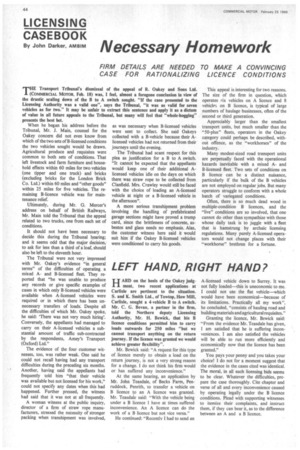Necessary Homework
Page 46

If you've noticed an error in this article please click here to report it so we can fix it.
FIRM DETAILS ARE NEEDED TO MAKE A CONVINCING CASE FOR RATIONALIZING LICENCE CONDITIONS
rTHE Transport Tribunal's dismissal of the appeal of R. Oakey and Sons Ltd.
(ComaRam, McrroR, Feb. 18) was, I feel, almost a foregone conclusion in view of the drastic scaling down of the B to A switch sought. "If the case presented to the Licensing Authority was a valid one", says the Tribunal, "it was as valid for seven vehicles as for two." It may be unfair to extract this sentence and apply it as a dictum of value in all future appeals to the Tribunal, but many will feel that "whole-hogging"
• presents the best bet.
When he began his address before the Tribunal, Mr. J. Main, counsel for the Oakey concern did not even know from which of the two sets of B-licensed conditions the two vehicles sought would be drawn. Agricultural produce and requisites were common to both sets of conditions. That left livestock and farm furniture and household effects within 60 miles for two vehicles (one tipper and one truck) and bricks (excluding bricks for the London Brick Co. Ltd.) within 60 miles and "other goods" within 25 miles for five vehicles. The remaining B-licence vehicle was for maintenance relief.
Ultimately, during Mr. G. Mercer's address ' on behalf of British Railways, Mr. Main told the Tribunal that the appeal related to two trucks, one from each set of conditions.
It should not have been necessary to decide this during the Tribunal hearing; and it seems odd that the major decision, to ask for less than a third of a loaf, should also be left to the eleventh hour.
The Tribunal were not very impressed with Mr. Oakey's evidence "in general terms" of the difficulties of operating a mixed Aand B-licensed fleet. They reported that "he was unable to produce any records or give specific examples of cases in which only B-licensed vehicles were available when A-licensed vehicles were required or in which there has been unnecessary transfers of loads. Despite all the difficulties of which Mr. Oakey spoke, he said: 'There was not very much hiring'. Conversely, the appellants had managed to carry on their A-licensed vehicles a substantial amount of traffic sub-contracted by the respondents, Amey's Transport (Oxford) Ltd."
The evidence of the four customer witnesses, too, was rather weak. One said he could not recall having had any transport difficulties during the preceding six months. Another, having said the appellants had frequently told him "that their vehicle was available but not licensed for his work," could not specify any dates when this had happened. Further pressed, the witness had said that it was not at all frequently.
A woman witness at the public inquiry, director of a firm of straw rope manufacturers, stressed the necessity of stronger packing when transhipment was involved, as was necessary when B-licensed vehicles were sent to collect. She said Oakeys collected with a B-vehicle because their Alicensed vehicles had not returned from their journeys until the evening.
The Tribunal had scant respect for this plea as justification for a B to A switch. "It cannot be expected that the appellants would keep one of their additional Alicensed vehicles idle on the days on which there was straw rope to be collected from Clanfield. Mrs. Crawley would still be faced with the choice of loading an A-licensed vehicle at night or a B-licensed vehicle in the afternoon".
A more serious transhipment problem involving the handling of prefabricated garage sections might have proved a trump card, since the brittleness of concrete, asbestos and glass needs no emphasis. Alas, the customer witness here said it would suit him if the Oakey B-licensed vehicles were conditioned to carry his goods. This appeal is interesting for two reasons. The size of the firm in question, which operates Fix vehicles on A licence and 8 vehicles on B licence, is typical of large numbers of haulage businesses, often of the second or third generation.
Appreciably larger than the smallest transport units, but much smaller than the "50-plus" fleets, operators in the Oakey category could perhaps be described, without offence, as the "workhorses" of the industry.
Many modest-sized road transport units are perpetually faced with the operational hazards inevitable with a mixed Aand B-licensed fleet. Two sets of conditions on B licence can be a distinct nuisance, particularly if the bulk of the B vehicles are not employed on regular jobs. But many operators struggle to conform with a whole batch of variegated conditions.
Often, there is so much dead wood in multiple-condition B licences, and the "live" conditions are so involved, that one cannot do other than sympathize with those whose daily task is to juggle with a fleet that is hamstrung by archaic licensing regulations. Many purely A-licensed operators would not change places with their "workhorse" brethren for a fortune.




























































































































